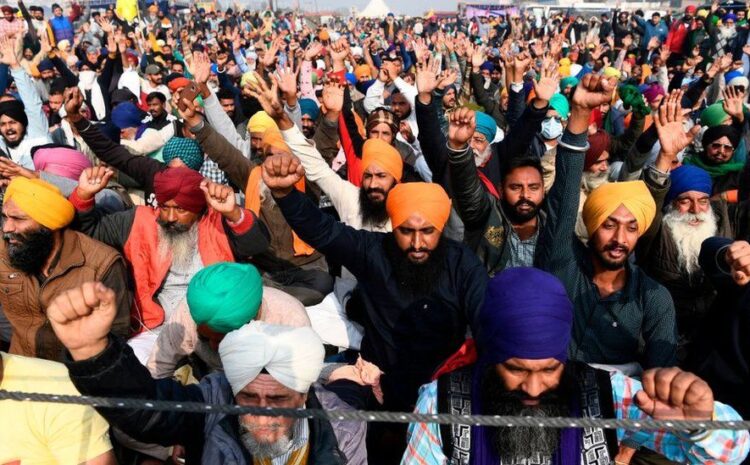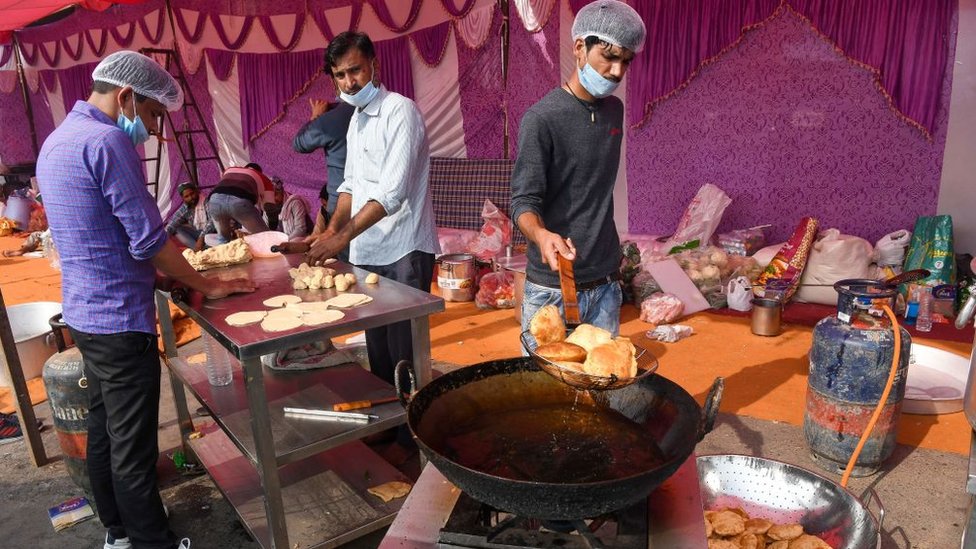
GETTY IMAGES image captionThousands of farmers are protesting against the laws at the Delhi border
India’s Supreme Court has put on hold three contentious farm laws that have sparked weeks of protests.
Farmers have been camped at the borders of capital Delhi since 26 November to protest against laws that will further open up agriculture to the free market.
At least four farmers at the protest site have killed themselves, and several others have died from ailments and the harsh winter cold.
Meanwhile, several rounds of talks with the government have failed.
On Tuesday, the court stayed the implementation of the laws “until further notice”, and appointed an independent committee to broker a deal between the farmers and the government.
The farmer groups have repeatedly said that they will settle for nothing less than a repeal of the laws, and the government has ruled out any rollback.
In the face of this stalemate, the top court had agreed to hear a batch of petitions challenging the laws.
While the court refused to adjudicate on the laws themselves, Chief Justice Sharad Bobde said they would intervene to try and resolve the matter given the spate of deaths at the protests.
Many of the farmers are elderly and have been living out in the open in the bitter cold and rain for nearly two months now.
“Each one of us will be responsible if anything goes wrong. We don’t want anybody’s blood on our hands,” Justice Bobde said during the hearing in court.
He also criticised the government for its handling of the matter, describing it as “extremely disappointing”.
The government has said the reforms will not hurt farmers. But farm groups say the laws threaten decades-old concessions and subsidies they receive, thwart their bargaining power and expose them to the vagaries of the market and big corporate companies.
What exactly do the laws propose?
Taken together, the laws loosen rules around sale, pricing and storage of farm produce – rules that have protected India’s farmers from the free market for decades.
One of the biggest changes is that farmers will be allowed to sell their produce at a market price directly to private players – agricultural businesses, supermarket chains and online grocers. Most Indian farmers currently sell the majority of their produce at government-controlled wholesale markets or mandis at assured floor prices.
 IMAGE COPYRIGHT GETTY IMAGES
IMAGE COPYRIGHT GETTY IMAGESThe reforms, at least on paper, give farmers the option of selling outside of this so-called “mandi system”.
But it’s unclear how this will play out in reality. For one, farmers can already sell to private players in many states but what these bills do is offer a national framework.
Farmers are mainly concerned that this will eventually lead to the end of wholesale markets and assured prices, leaving them with no back-up option. That is, if they are not satisfied with the price offered by a private buyer, they cannot return to the mandi or use it as a bargaining chip during negotiations.
Are these reforms necessary?
Most economists and experts agree that Indian agriculture desperately needs reform.
More than half of Indians work on farms, but the sector accounts for barely a sixth of the country’s GDP. Declining productivity and a lack of modernisation have shrunk incomes and hobbled agriculture in India for decades.
The government, meanwhile, provides farmers with generous subsidies, exempts them from income tax and crop insurance, guarantees a minimum price for 23 crops and regularly waives off debts.
But none of this seems to have helped Indian farming much as low incomes and debt continue to drive many farmers to poverty.
So, experts say, the sector needs deeper structural reforms, but only after consultations with stake holders and political parties.
Critics say the government’s reforms have been poorly conceived and pushing them during a pandemic without consulting the main stakeholders flies against India’s federalist traditions.
